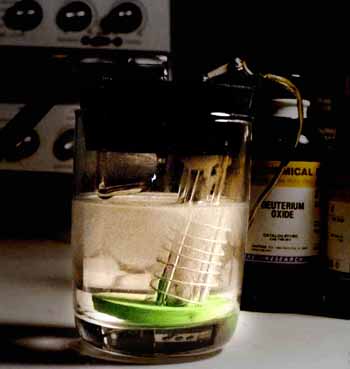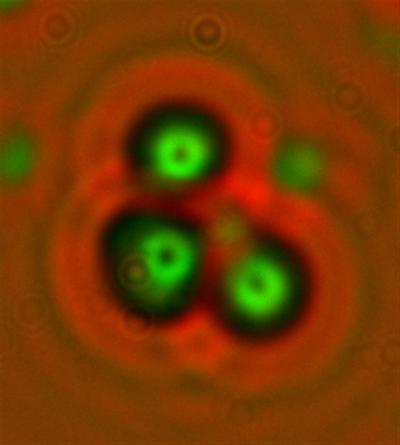Keywords: cold fusion, Mosier-Boss, rediscovered, 20 year perspective, not dead, dead?, Salt Lake City, Mormon, University of Utah Pons, Fleischmann, 1989, March, pictures, original research, excess, helium, neutrons, triplet, heat, heavy water, deuterium, Pam Boss, photo, picture, 2009
| ~ @Com ~
On the net Since 1994 |
Cold Fusion 2009 |
From FOX News... "Fair and Balanced" ?! |
|
HOME -
In the new study, Mosier-Boss and colleagues inserted an electrode composed of nickel or gold wire into a solution of palladium chloride mixed with deuterium... |
Navy chemist have discovered
neutron emission from Cold Fusion. March 25,
2009 Now a U.S. Navy researcher, speaking on the anniversary of and in the same city where they made their announcement, thinks Fleischmann and Pons may have been right. In a paper presented on Monday, chemist
Pamela Mosier-Boss told the annual convention of the American Chemical
Society in Salt Lake City that her team had gotten "very significant"
evidence of some sort of nuclear reaction. |
|
|
|
 Nuclear Transmutation: The Reality of Cold Fusion
God's
Debris It's a Treasure! ...and it's FREE
Synopsis |
|
PLAY
Andy's
Amazing Card Trick -- Free |
||
Cold fusion rebirth?
New evidence for existence of controversial energy
source
SALT LAKE CITY, March 23, 2009 — Researchers are reporting
compelling new scientific evidence for the existence of low-energy
nuclear reactions (LENR), the process once called "cold fusion" that may
promise a new source of energy. One group of scientists, for instance,
describes what it terms the first clear visual evidence that LENR
devices can produce neutrons, subatomic particles that scientists view
as tell-tale signs that nuclear reactions are occurring.
Low-energy nuclear reactions could potentially provide 21st Century
society a limitless and environmentally-clean energy source for
generating electricity, researchers say. The report, which injects new
life into this controversial field, will be presented here today at the
American Chemical Society's 237th National Meeting. It is among 30
papers on the topic that will be presented during a four-day symposium,
"New Energy Technology," March 22-25, in conjunction with the 20th
anniversary of the first description of cold fusion.
|
Mosier-Boss and colleagues inserted an electrode composed of nickel or gold wire into a solution of palladium chloride mixed with deuterium ... |
"Our finding is very significant," says study co-author and analytical chemist Pamela Mosier-Boss, Ph.D., of the U.S. Navy's Space and Naval Warfare Systems Center (SPAWAR) in San Diego, Calif. "To our knowledge, this is the first scientific report of the production of highly energetic neutrons from an LENR device."
The first report on "cold
fusion," presented in 1989 by Martin Fleishmann and Stanley Pons, was a
global scientific sensation. Fusion is the energy source of the sun and the
stars. Scientists had been striving for years to tap that power on Earth to
produce electricity from an abundant fuel called deuterium that can be
extracted from seawater. Everyone thought that it would require a
sophisticated new genre of nuclear reactors able to withstand temperatures
of tens of millions of degrees Fahrenheit.
Pons and Fleishmann, however, claimed achieving nuclear fusion at
comparatively "cold" room temperatures — in a simple tabletop laboratory
device termed an electrolytic cell.
But other scientists could not
reproduce their results, and the whole field of research declined. A
stalwart cadre of scientists persisted, however, seeking solid evidence that
nuclear reactions can occur at low temperatures. One of their problems
involved extreme difficulty in using conventional electronic instruments to
detect the small number of neutrons produced in the process, researchers
say.
In the new study, Mosier-Boss and colleagues inserted an electrode composed
of nickel or gold wire into a solution of palladium chloride mixed with
deuterium or "heavy water" in a process called co-deposition. A single atom
of deuterium contains one neutron and one proton in its nucleus.
Researchers passed electric current through the solution, causing a reaction
within seconds. The scientists then used a special plastic, CR-39, to
capture and track any high-energy particles that may have been emitted
during reactions, including any neutrons emitted during the fusion of
deuterium atoms.
At the end of the experiment, they examined the plastic with a microscope
and discovered patterns of "triple tracks," tiny-clusters of three adjacent
pits that appear to split apart from a single point. The researchers say
that the track marks were made by subatomic particles released when neutrons
smashed into the plastic. Importantly, Mosier-Boss and colleagues believe
that the neutrons originated in nuclear reactions, perhaps from the
combining or fusing deuterium nuclei.
"People have always asked 'Where's the neutrons?'" Mosier-Boss says. "If you
have fusion going on, then you have to have neutrons. We now have evidence
that there are neutrons present in these LENR reactions."
They cited other evidence for nuclear reactions including X-rays, tritium
(another form of hydrogen), and excess heat. Meanwhile, Mosier-Boss and
colleagues are continuing to explore the phenomenon to get a better
understanding of exactly how LENR works, which is key to being able to
control it for practical purposes.
Mosier-Boss points out that the field currently gets very little funding
and, despite its promise, researchers can't predict when, or if, LENR may
emerge from the lab with practical applications. The U.S. Department of the
Navy and JWK International Corporation in Annandale, Va., funded the study.
Other highlights in the symposium include:
Overview, update on LENR by editor of
New Energy Times – Steve Krivit,
editor of New Energy Times and author of "The Rebirth of Cold Fusion," will
present an overview of the field of low energy nuclear reactions, formerly
known as "cold fusion." A leading authority on the topic, Krivit will
discuss the strengths, weaknesses, and implications of this controversial
subject, including its brief history. (ENVR 002, Sunday, March 22, 8:55 a.m.
Hilton, Alpine Ballroom West, during the symposium, "New Energy Technology)
Excess heat, gamma radiation production from an unconventional LENR device —Tadahiko
Mizuno, Ph.D., of Hokkaido University in Japan, has reported the production
of excess heat generation and gamma ray emissions from an unconventional LENR device that uses phenanthrene, a type of hydrocarbon, as a reactant. He
is the author of the book "Nuclear Transmutation: The Reality of Cold
Fusion." (ENVR 049, Monday, March 23, 3:35 p.m., Hilton, Alpine Ballroom
West, during the symposium, "New Energy Technology.")
New evidence supporting production and control of low energy nuclear
reactions — Antonella De Ninno, Ph.D., a scientist with New Technologies
Energy and Environment in Italy, will describe evidence supporting the
existence of low energy nuclear reactions. She conducted lab experiments
demonstrating the simultaneous production of both excess heat and helium
gas, tell-tale evidence supporting the nuclear nature of LENR. She also
shows that scientists can control the phenomenon. (ENVR 064, Tuesday, March
24, 10:10 a.m., Hilton, Alpine Ballroom West, during the symposium, "New
Energy Technology)
The American Chemical Society is a nonprofit organization chartered by the U.S. Congress. With more than 154,000 members, ACS is the world's largest scientific society and a global leader in providing access to chemistry-related research through its multiple databases, peer-reviewed journals and scientific conferences. Its main offices are in Washington, D.C., and Columbus, Ohio.
Contact: Michael Bernstein
m_bernstein@acs.org
American Chemical Society
Note to
journalists: Please report that this research was presented at a meeting of
the American Chemical Society
Source:
eurekalert.org





